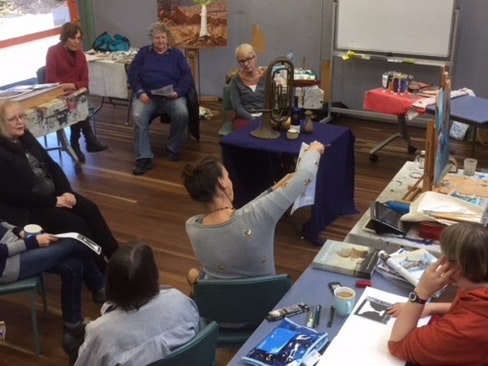How to Learn Painting at Home for Beginners
Learning to paint might seem challenging, but it doesn’t have to be. For aspiring artists out there, we list the steps for you to enjoy painting at home as beginners.

Welcome to the wonderful world of painting! Whether you’re just starting out as a painter or want to pick up at home after taking an art class, this article will show you how to enjoy painting at home. We list some first steps to take and basic techniques that you can use right away, plus a few advanced tips for those who are dedicated to improving their craft.
Can’t wait to paint with all the colours? Let’s get started!
Discover Painting at Home in 5 Easy Steps
Paintings add that special touch to any space, don’t they? Whether it’s a serene landscape or a burst of abstract colours, they really tie a room together. If you’re diving into the world of painting for the first time, it’s all about getting those basics down. Let’s dive right in!
1. Set Up Your Painting Space
First things first, you’ll need a good ol’ easel. It’s like the MVP of your painting kit. Whether you’re dabbling in oils, watercolours, or even pencils, investing in a decent easel is key. Look for one with adjustable height, so you can stand or sit comfortably while you work.
Use a table for your paints and brushes
And don’t forget about your workspace! A dedicated table for your paints and brushes will save you from a world of messy accidents. Trust me, keeping things organised will save you loads of time and frustration.
2: Choose Your Tools Wisely
Quality brushes and canvas are your best pals in this painting adventure. Splurge a bit if you can - you won’t regret it. High-quality gear makes a world of difference in how your paint glides on and how long your supplies last. They also last longer, so you don’t have to replace them so often. Cheap materials, on the other hand, will result in poor work, no matter how much time you spend practising or what techniques you learn from art classes and workshops.
Brushes come in different sizes, shapes, and materials. Some have synthetic bristles while others have natural ones like sable or mongoose hair. For oil painting, choose natural hair brushes because they hold more paint and give me more control over the shape of your strokes. For acrylics or watercolour painting, where you don’t need as much pigment retention as with oil paints, there are some good, inexpensive synthetic brushes out there.
3. Find Your Inspiration
Time to get those creative juices flowing! Whether it’s a vibrant still life or a whimsical portrait, find a subject that speaks to you. And hey, don’t be afraid to put your own spin on things. Originality is where the magic happens!
One of the ways new artists learn how to paint is by copying a painting by another artist or from an image in art books. Sure, this can help you to get your bearings, by letting you focus on the technical side of things rather than worrying about originality. However, if you want to grow as a painter, focus on finding your own original style. Don’t be afraid to experiment!
4. Sketch it Out
Every masterpiece starts with a simple sketch. Take a moment to outline your vision on paper before you dive into the paint. It’ll help you get a feel for shapes and proportions, trust me, it’s worth it. There are many different types of painting techniques, but it is often great to begin with a simple drawing. We list some great ideas here and here.
5. Let’s Get Mixing
Ah, the joy of colours! Learning to mix and blend hues is like mastering your own little rainbow. Start with the basics - red, blue, yellow - and see where your imagination takes you. Don’t be afraid to experiment and let your creativity shine!
The best way to learn how to combine and harmonise colours in your artwork is by using the colour wheel, a visual tool that shows the relationships between colours 12 main in an easy-to-view circle. This diagram will be your best friend as a beginner learning to paint at home! Use it to expand your knowledge of paint colour combinations and come up with some ideas! For example, you can create a monochromatic scheme by working with different shades, tints, and tones of a single colour.
The next step is understanding complementary colours: those opposite each other on the colour wheel, like reds and greens, blues and oranges. When painted side-by-side, their brightness will intensify and appear even bolder than before. These opposites work well for creating contrast and helping certain objects stand out more than they might otherwise look against a background or on their own.
Bonus Tip: Try Different Techniques
Feeling adventurous? Give watercolours, oils, or acrylics a whirl. Each medium has its own unique charm, so don’t be shy about exploring. You never know what you might fall in love with!
And there you have it - your crash course in painting at home! Remember, the most important thing is to have fun and let your creativity flow. Happy painting!
Learning to paint at home as a beginner is fun and may surprise you. You are always going to learn something new, and that is an exciting hobby to have, especially if you have never picked up a brush before.
With the right instruction and motivation, painting is perfect for anyone to try at any age. Discover how to learn painting at home today!
Learn how to paint and make art anywhere!

